|
|
Post by Admin on Feb 13, 2019 20:36:29 GMT
 Russia has deep Finno-Ugric roots. Rurik, a Varangian chieftain of the Rus', is the founder of the Rurik Dynasty and its successor states, including the Grand Duchy of Moscow and the Tsardom of Russia. The Rurik clan also had Finnic ancestry with Finno-Ugric hg N1c (N-Y10931: 1,750 ybp) and its date of origin largely coincides with the emergence of the Varangians in Western Russia. The Varangian prince Rurik established himself in Novgorod around the year AD 862 and he was originally from today's Finland. In a way, it was a Finnish conquest of the Slavic land.  Typically Finno-Ugric N1c are all branches which are either L1026* or descended from L1026; while typically Baltic N1c is only M2783 (young and descended from typically Ugro-Finnic L1026) and Rurikid N1c is Y4338, which is also young, and also descended from L1026. It appears that he had originated from Finno-Ugrians. 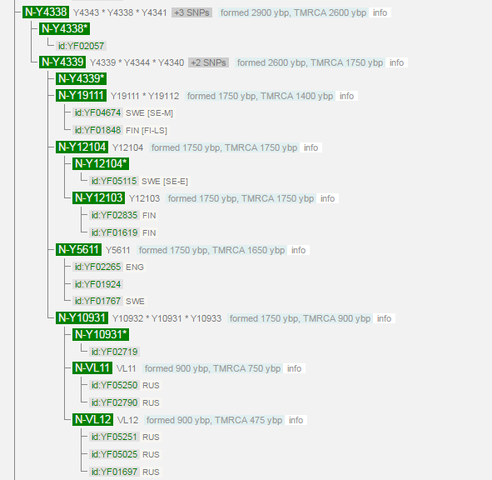 The Y4338 subclade is named "Para-Rurik" (Russian: парарюрикидов), which was originally formed 2,900 years ago in Finland. The Rurik clan belonged to N-Y10931 (1,750 ybp) and its date of origin largely coincides with the emergence of the Varangians in Western Russia and its descendant subclades such as N-VL11 and N-VL12 (900 ybp) are only found in Russia.  The Varangians had been roaming around the areas north of the Black Sea, engaging in piracy and mercenary activities, long before Rurik's supposed arrival to the Slavic heartland. The Slavs and the Varangian Rus' admixed for many centuries and the Varangians may have gone native in region by the time when the Rurik dynasty was established.  The Ukrainian language traces its origins to the Old East Slavic language of the medieval state of Kievan Rus'. Ukrainian, along with all other East Slavic languages, is a descendant of the colloquial language used in Kievan Rus' (10th–13th century). Ukraine was a regional part of the state of Kievan Rus' and the first distinctly "Ukrainian" state (Halych-Volhynia: 1199–1349) was the cultural successor to Kievan Rus, which was founded after the disintegration of Kievan Rus'.  After the death of Yaroslav the Wise in 1054, a protracted battle for the succession embroiled and, ultimately, partitioned Kievan Rus. Vseslav the Sorcerer, the pagan prince of Polotsk, seized and burned Novgorod and, after Yaroslav’s three sons were defeated in battle by the Turkic Cumans in 1068, he seized Kiev itself, briefly claiming kingship of Rus. Kievan Rus would again achieve some semblance of unity under Vladimir II Monomakh (1113–25) and his son, Mstislav the Great (1125–32) but, by then, other factors were precipitating its decline. The establishment of the crusader kingdom of Jerusalem had opened alternative trade routes to those afforded by Rus; this was accentuated by Constantinople’s decline following its sacking by crusaders in 1204. The growing Cuman Empire, based around the Black Sea, impeded the trade of Rus itself, while Volga Bulgaria controlled the route to the Caspian.  The tributaries of the Varangians drove them back beyond the sea and, refusing them further tribute, set out to govern themselves. There was no law among them, but tribe rose against tribe. Discord thus ensued among them, and they began to war one against the other. They said to themselves, "Let us seek a prince who may rule over us, and judge us according to the Law". They accordingly went overseas to the Varangian Russes: these particular Varangians were known as Russes, just as some are called Swedes, and others Normans, English, and Gotlanders, for they were thus named. The Chuds, the Slavs, the Krivichians and the Ves' then said to the people of Rus', "Our land is great and rich, but there is no order in it. Come to rule and reign over us". Thus they selected three brothers, with their kinsfolk, who took with them all the Russes and migrated. The oldest, Rurik, located himself in Novgorod; the second, Sineus, at Beloozero; and the third, Truvor, in Izborsk. On account of these Varangians, the district of Novgorod became known as the land of Rus' (The Russian Primary Chronicle pp. 59-60.) |
|
|
|
Post by Admin on Feb 14, 2019 20:38:34 GMT
 Since it was found out that many Russian noble families, which derive their paternal lineage from the mythic Rurik, represent the haplogroup N1c1, many people have taken this as an evidence about the Finno-Ugric origin of the "genetic Rurik". However, a haplogroup itself can tell nothing about the language of its carriers. The scientific procedure to find out the language of the "genetic Rurik" is to locate his ancestral paternal root, and then see which language was spoken in that area at that time.  This means that the results of both genetics and linguistics must be considered independently – genetic results should not twist the linguistic results, or vice versa. Here I shall root the "genetic Rurik" (= paternal ancestor of all the related Rurikid families, no matter what the real name of this biological ancestor was) in the N1c1-haplotype tree. In my STR-based haplotype tree I shall also utilize the continuously updated SNP-based haplogroup tree (see Northern Eurasian N -project). The STR-based tree is not alone as reliable as the SNP-based tree, because there may occur back-mutations and independent parallel mutations in the STR-tree. Still, we get much higher resolution with the STR-tree: many haplotypes which share the common SNP mutations usually differ at least by few STR-mutations. By combining the STR-level and the SNP-level we get the most reliable and the most resolute tree.  I start from the reconstructed Central European founder haplotype, socalled Proto-L550, which is the common ancestor of all the L550-branches of N1c1 (the Balto-Polish, the Spanish and the Scandinavian branches). This in turn is reconstructed with the help from both descending and ascending haplotypes, that is: the haplotypes following and preceding the mutation L550. (See www.mv.helsinki.fi/home/jphakkin/N1c1.pdf)  Every STR-mutation (e.g. DYS390) within the range of 111 markers (loci) is taken into consideration, and so are all the SNP-mutations (e.g. L550) which are considered certain and diagnostic. When I present an existing individual haplotype, its FamilyTreeDNA kit number is marked in Italic, like 50530. When I present a calculated modal haplotype (MHT consists of the most common value within a group of closely related haplotypes in every locus), or a reconstructed founder haplotype (FHT consists of the most ancestral values within a group of closely related haplotypes in every locus; FHT can only be reconstructed when the group is rooted in the haplotype tree) the kit numbers are shown in Italic in brackets, like (184210, 205133). New mutations are marked in red, and old mutations in blue. Markers with plain blue have not gone through any mutations after the root FHT (here Proto-L550). Contradicting or ambiguous mutations are marked in violet.  Fequency map of the concentration of N1c1 The famous Mongol Expansion haplogroup is actually C3, which is the modal haplogroup of Mongolians. In contrast, N1c1 has existed in Europe for thousands of years, and is far to old and too wide-spread to represent a recent expansion. Based on the current distribution, and the diversity being modal in the East Baltic, one has to be skeptical of a simple east-west model. Interestingly the frequency difference of this haplogroup between Finland and Sweden is very high. Also, branch of N1c1 seems to be found among the Rurikids of Russia. This was the ruling dynasty of the Rus, a people who originally seem to have been ethnic Scandinavians from Sweden.  The name of Russia or Руси originated from the Rus' people, who formed the ancient Russian state of Kievan Rus'. The use of the concept of Russia was limited only to the Principality of Kiev possessed by the Rurik Dynasty until the 12th century and the name was gradually passed to all Rus' fiefdoms afterwards. In historiography, the term Rus covers the entire territory of the Old Russian state since its foundation in 862. The Grand Duchy of Moscow claimed the title of "the Grand Duke of all Rus'" to form a united Russian state in the mid-14th century. When the Mongols invaded the lands of Kievan Rus' in the 13th century, Moscow was the remote outpost, which was spared from Mongol attacks and occupation. |
|
|
|
Post by Admin on Feb 15, 2019 22:22:31 GMT
 There is a debate over how Rurik came to control Ladoga and Novgorod. The only information about him is contained in the 12th-century Russian Primary Chronicle, which states that Chuds, Slavs, Merias, Veses and Krivichs drove the Varangians back beyond the sea, refused to pay them tribute, and set out to govern themselves. Afterwards the tribes started fighting each other and decided to invite Rurik to reestablish order. Rurik remained in power until his death in 879. It was found that Rurik was of Varangian origin (a sub-branch in the N1c1 genetic haplogroup). Since his genetic haplotype, that can be anticipated from more than 10 results of modern Rurikid princes, best matches one of the haplotypes of the Swedes, one may eventually conclude that he was of Swedish descent. And the further testing of the DNA results of 191 men claiming to be Rurik descendants indicate that most - 68% - of the them had haplogroup N1c1.  This haplogroup is distributed throughout Northern Eurasia. It is the most common Y-chromosome type in Uralic speakers (Finns and Native Siberian). This lineage most likely originated in northern China or Mongolia and then spread into Siberia where it became a very common line in western Siberia. N1c1d(L550) Varangian N1c1d1a (L550) A lineage established in Scandinavia, Baltic Europeans, a Varganian marker in Southern Europe Based on medieval & Histroical sources, Rurik was born on the Roslagen seashore, which is located north of Stockholm in the modern-day Sweden. But for along time some had thought that he had may have been born in Germany. We now know for sure because of this DNA testing that he was born on the Roslagen seashore in Sweden the only area in Sweden where the Y- DNA haplogroup N1c1d(L550) Varangian appears. There have been several indirect proofs that people in this region were called Rhos(s) in the Middle Ages. This word is pronounced “roos” in Swedish, which sounds like Russia today. Probably the Finnish word “Ruotsi” (Sweden) also comes from this word |
|
|
|
Post by Admin on Feb 16, 2019 18:31:33 GMT
Rurikid Dynasty DNA Project The project began in 2006 when practically no one knew from whom and from where the Rurikid princes came from. It was also unclear whether the Rurikid princes were descended from a single male. The Russian Newsweek Magazine tested the first prince (Professor Dmitri Shahovskoy of France) who was found to belong to the N1c1 genetic haplogroup. The Russian Newsweek had later confirmed his result by testing two other princes, namely Prince Andrei Gagarin of Russia and Prince Nikita Lobanov-Rostovsky of Great Britain. Many new tests have been performed in this project. Although some of the princes do not share the N1c1 hapologroup, by all means we can now say that the N1c1 haplogroup was shared at least by Prince Svatoslav Igorevich (father of St. Vladimir the Great of Kiev, and the grandson of Rurik). All of the N1c1 Rurikid princes’ haploptypes begin with (the FTDNA’s standard) 14 23 14 11 11 13 11 12 10 x 14 x 18 9 9 … . People who have such haplotypes, as well as those who have documents proving their Rurikid descent, or if their descent from Rurik is well confirmed by family tradition, are welcome to join this project. 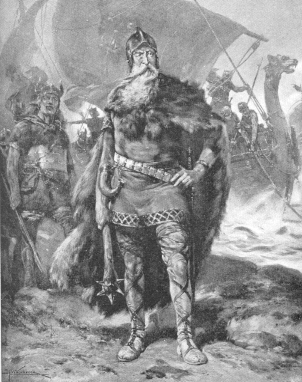 It has also been discovered that Gedimin(as), the Grand Duke of Lithuania, and Rurik were very distant cousins. They shared a common male ancestor ab. 2200 years back. The haplotypes of the Gediminid princes, which begin with 14 23 15 11 11 13 11 12 10 x 15x 17 9 9 …, are also within the scope of this project. The administrators of this project until 2008 were co-operating with Stepan Kravchenko and Nikita Maximov, who were the Editor-in-Chief and the Scientific Editor of the Russian Newsweek Magazine, respectively. The Russian Newsweek tested the first two Rurikid princes. The first one was Prince Dmitri Mikhailovich Shahovskoi of Paris, France, the prominent Professor at the Russian Orthodox Institute, who made the 1st Y-DNA test in the Rurikid Dynasty (at the end of 2006). Unexpectedly, he was found to belong to the genetic haplogroup N1c1 – the so-called “Finno-Ugrian”. 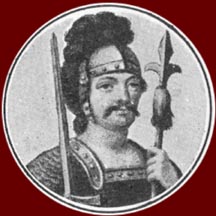 Igor Grand Prince of Kiev 924 - 945 Later, however, it was discovered that the N1c1 Rurikid princes belong to the so-called “Varangian Branch” in this haplogroup. This branch is one that is quite different from the present population of Finland (which is the “Finno-Karelian Branch”). The 2nd one was Professor Andrei Petrovich Gagarin of St. Petersburg, Russia, now deceased. His Y-DNA test result matched that of Prof. Shahovskoi. Professor Gagarin's test was confirmed later by the test of his cousin, Prince Grigori Grigorievich Gagarin. Andrei Gagarin was also the 1st Rurikid prince to have done a DeepClade N test (this proved that his haplotype, in fact, belonged to the N1c1 haplogroup). Since the Russian Newsweek Magazine had tested only 25 markers for him, he later joined the Rurikid Dynasty DNA Project and his test was upgraded to 67 markers (FTDNA Co.'s standard). This also became the case with Professor Dmitri Shahovskoi. The Rurikid Project gave him an entirely new (67 markers) test from the very beginning, since an incomplete12 markers test was made earlier for him by the Russian Newsweek. 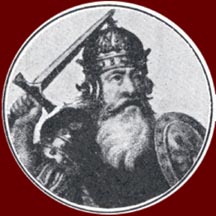 Svyatoslav I Grand Prince of Kiev 945 - 972 Next came Alexandr Solomin of Russia. For many years it was believed that his family was, in fact, a lost branch of the Monastyrev family. The Monastyrevs of Smolensk lost the rights to their princely title as early as the 16th cent. Since his Y-DNA test result seemed to be matching those of Shahovskoi and Gagarin, for a long time he was declared to be a Rurikid prince. However, new haplotypes in the Rurikid dynasty, and especially that of Prince Nicholas Rzhevsky of Smolensk, had shown that this was not really so. The 5th one was Prince Puzyna of Poland who was tested by the Rurikid Project. The 6th one was Prince Nikita Dmitrievich Lobanov-Rostovsky of Great Britain, who was tested by the Russian Newsweek. His result matched those of Shahovskoy, Rzhevsky and Puzyna, as well as those of the two Gagarins. Prince Lobanov-Rostovsky later joined the Rurikid Project and his 67 markers were repeated in this project from the very beginning. |
|
|
|
Post by Admin on Feb 17, 2019 18:38:48 GMT
The first prince who was tested by the Rurikid Project, and who was found to belong to the R1a1 haplogroup, was Piotr Szuyski of Poland, probably the last male Szuyski in the world. The Rurikid Project had also discovered that Prince Stanislaw Antoni Czetwertynski of Poland belongs to the I2a2 haplogroup. Since this haplogroup is also typical for inhabitants of the Ukrainian-Belarussian Polissya (Polesie) region it seems that Prince Tur(e),who founded the dynasty of the Turov-Pinsk princes, had originated from the local population. It is quite probable that he was married either to a sister or a daughter of Rurik, and in such a way he joined the Rurikid clan. This could also be the case with the Szuyski princes. 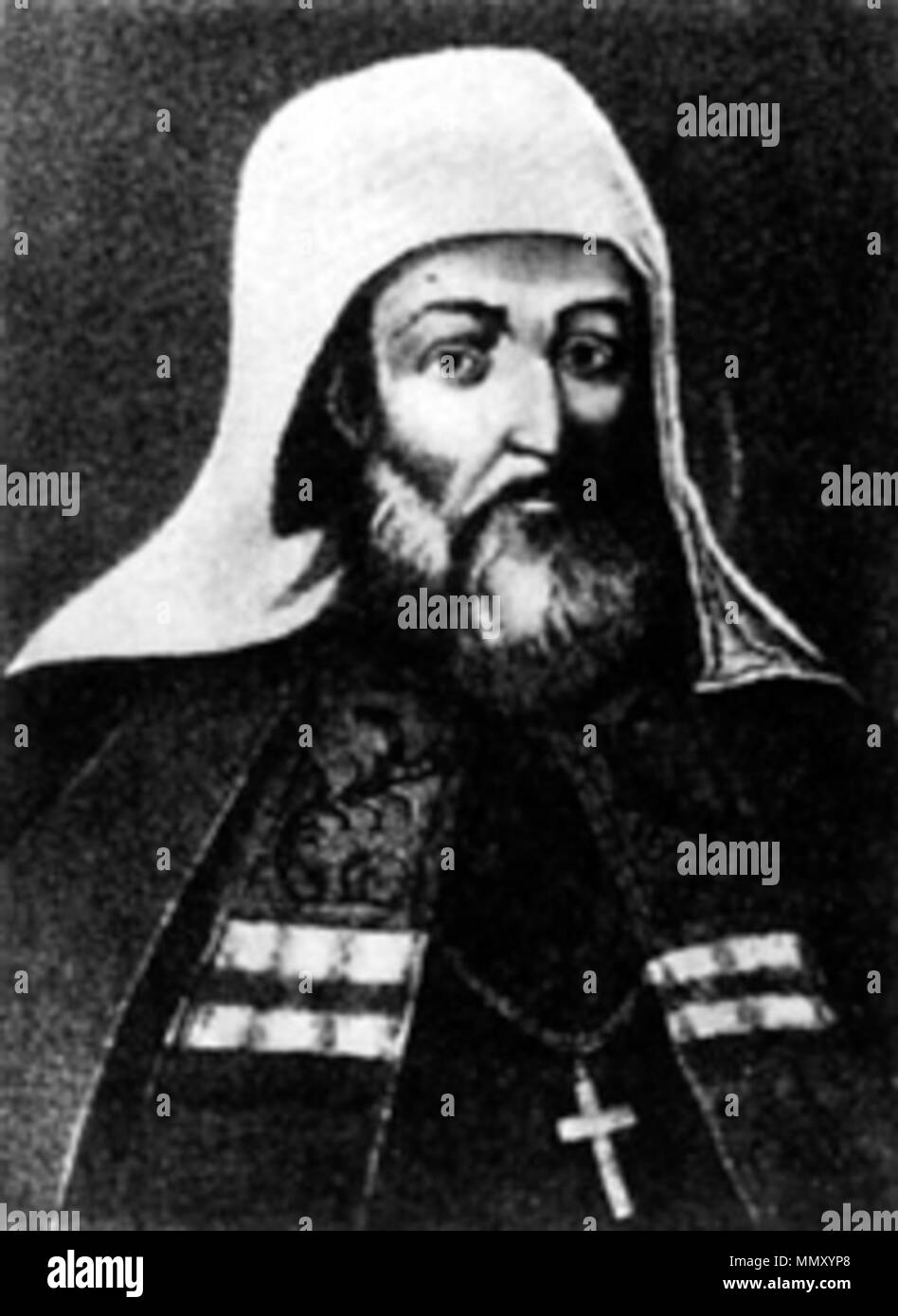 Next the following Rurikid princes were tested in the Rurikid Project : Putyatin, Kropotkin, Khilkov, Vadbolsky, Myshetsky (all of them belong to the N1c1 haplogroup) and Volkonsky (R1a1). The Russian Newsweek had earlier tested Prince Obolensky (R1a1). However, again, his test (67markers) was repeated in the Rurikid Project. All of the N1c1 princes, with the exception of Myshetsky, match well with the other Rurikids. Prince Myshetsky, who probably is also the last male Myshetsky in the world, belongs to the same N1c1 haplogroup. However, by no means is he a direct descendant of Rurik. 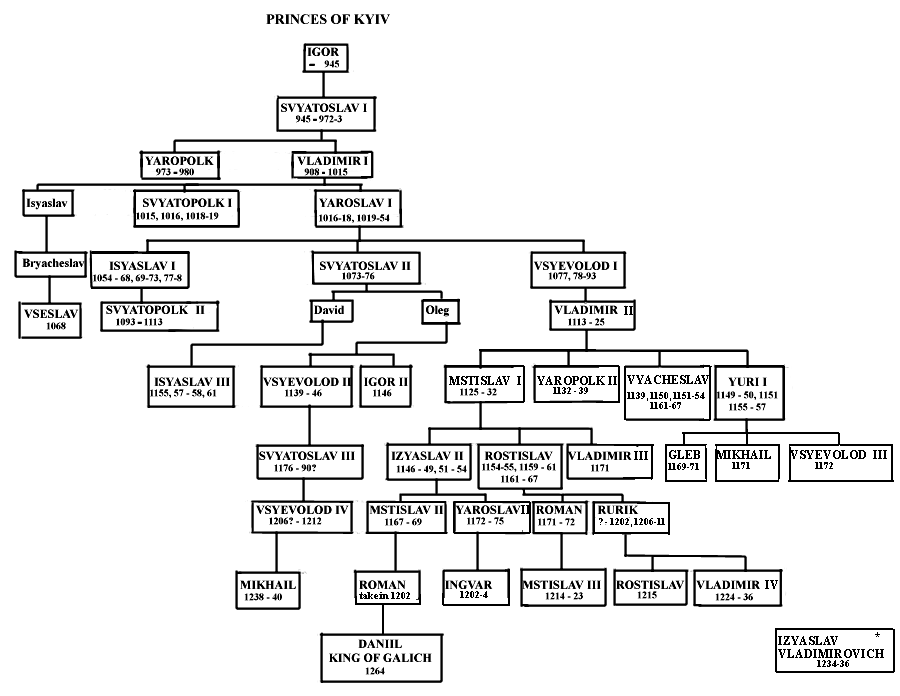 Thanks to Stanislaw Dumin, a prominent genealogist, the Rurikid Project has tested the following princes : Droutskoy-Sokolinsky (Drucki), Belosselsky-Belozersky and Bariatynsky (all belong to the R1a1 haplogroup; however, none of the three is a cousin to either of the other two among them), as well as Prince Massalski of Poland (N1c1). Prince Massalski matches well with the other N1c1 Rurikids. However, since he comes from another branch in the Rurikid dynasty, his test result is a direct proof that the N1c1 haplogroup had already been shared by Prince Yaroslav Mudry (the Wise), the son of St. Vladimir the Great of Kiev. 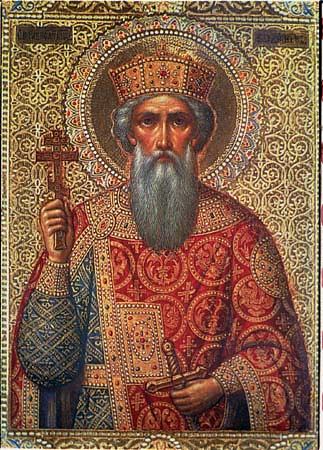 Vladimir the Great of Kiev Last but not least are the results of Prince Korybut-Woroniecki. His 25 markers were tested by Marek Skarbek-Kozielulski in his genetic project. He simply believed that he is a Gediminid prince. However, the test result confirmed what some historians had said: that he is a Rurikid. The Rurikid Project has ordered an upgrade for him to 67 markers. Nevertheless, this is what can be said now: Vasily Shuysky by no means was the last Rurikid on the Russian throne, at least in a genetic sense of the word "Rurikid". The last ruling Rurikid was the King of Poland and the Grand Duke of Lithuania Michal Korybut-Wisniowiecki (the Wisniowieckis and the Woronieckis are related by blood). 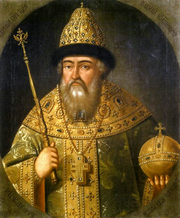 Portrait of Vasili IV The above database also includes Gediminid princes that were solely tested in the Rurikid Project : Khilkov (Chilkow), Golitsin (Golicyn) and Trubetskoy (Trubecki). They match well with another Troubetzkoy prince who took his Y-DNA test himself, as well as with Alex Chartorisky (Czartoryski) of Australia. Alex’s ancestors came from Russia and were boyars in the Moscow Gubernya. Most probably one of the Czartoryskis was captured by the Russians as a POW in the war of 1500-1503 between Muscovy and the Grand Duchy of Lithuania, and later he decided to settle himself in Moscow.  Prince Jerzy Czartoryski of Canada decided to have his Y-DNA tested in the Rurikid Project in spite of what historians speculate(d) about the descent of his princely branch. In the memoires of Armand Louis de Gontaut-Biron it was said that it was he who, in fact, fathered this branch in the Czartoryski princely family. Prince Jerzy was found to be descended from a Germanic tribe (R1b1), to which a lot of French people belong. However, in case of a discrepancy between traditional and genetic genealogies, this is just a documented genealogy which counts here, i.e. that princes in this branch inherited their surname, their title, their possessions and family tradition from their legitimate ancestors, the Czartoryski princes. On the other hand, however, provided that he is really descended from the Gontaut-Birons, this duly means that he is also a genetic descendant of this old French family, which, possibly, may have its roots in the time of the Merovingian or the Carolingian kings of France. |
|





















